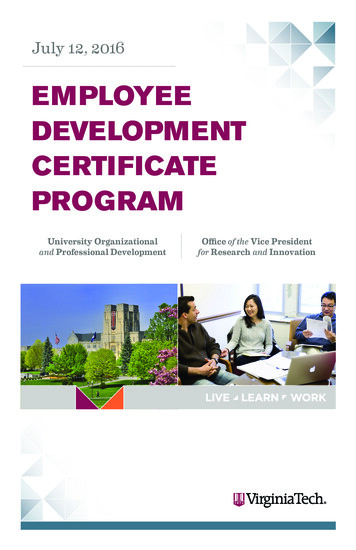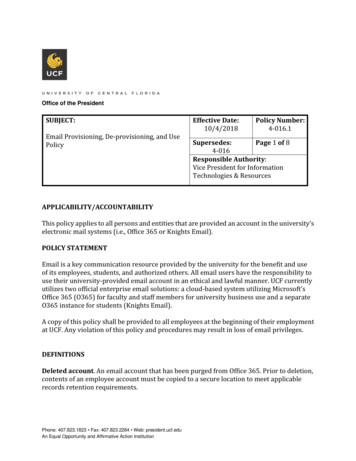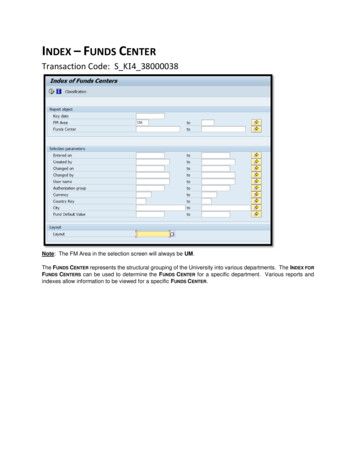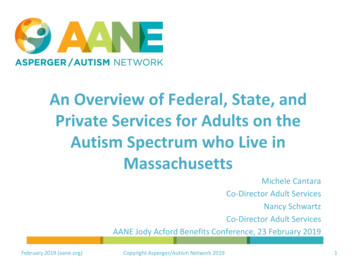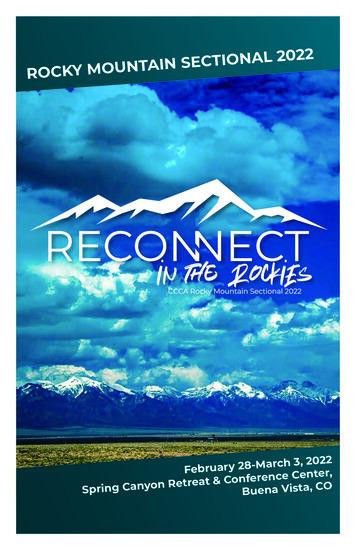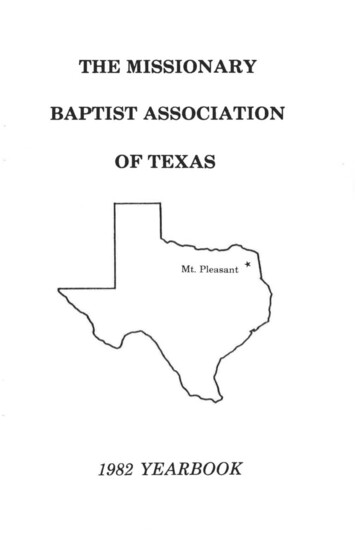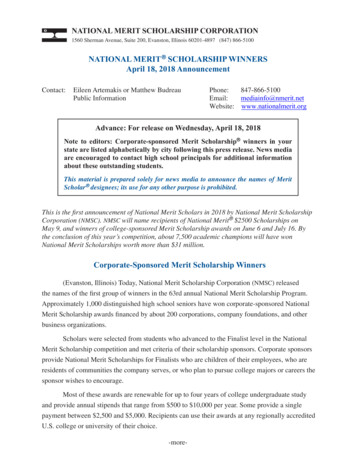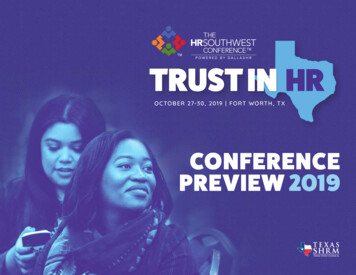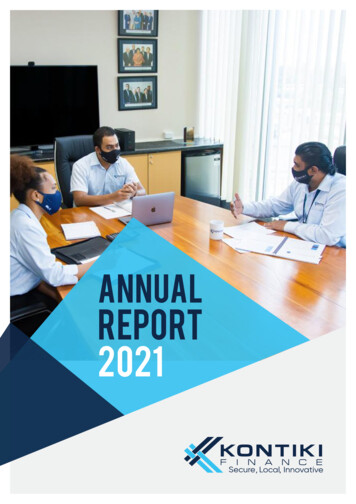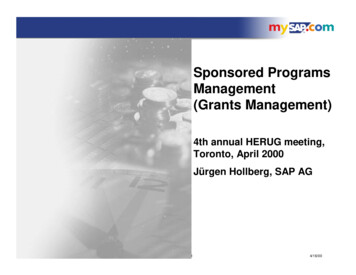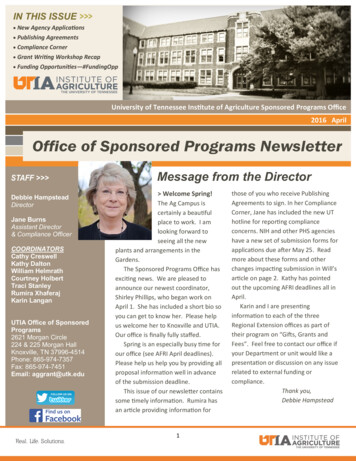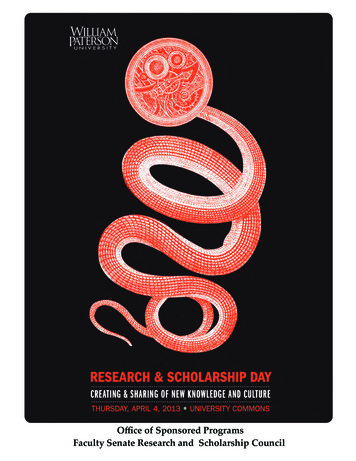
Transcription
Office of Sponsored ProgramsFaculty Senate Research and Scholarship CouncilPage 1
University Research and Scholarship Day 2013Sponsors and SupportersFaculty Senate Researchand Scholarship CouncilOffice of Sponsored ProgramsDavid Gilley, College of Scienceand Health, ChairSandra Alon, College of EducationSheetal Ranjan, College of Humanities andSocial SciencesJorge Arevalo, Cotsakos College of BusinessRobin Schwartz, College of Arts andCommunicationSusan Sgro, College of Science and HealthJane Bambrick, David and Lorraine Cheng LibraryMartin Williams, Office of Sponsored ProgramsLourdes Bastas, Office of Sponsored ProgramsMartin Williams, DirectorLourdes Bastas, Assistant DirectorMaureen Peters, Program AssistantCleavens Estriplet, Post‐Award CoordinatorMichael Ehlers, Graduate AssistantEverett Andrews, Undergraduate AssistantAshley Algarin, Undergraduate AssistantDavid and Lorraine Cheng LibraryAnne Ciliberti, DeanCenter for Research,College of Science and HealthCotsakos College of BusinessBetty Kollia, DirectorKenneth Wolf, DeanRajiv Kashyap, Interim DeanStephen Hahn, Associate Provost forAcademic AffairsCollege of EducationCollege of Humanities andSocial SciencesCandace Burns, DeanKara Rabbitt, DeanCollege of Arts and CommunicationCross Cultural Arts Festival:North & East AsiaStephen Hahn, Interim DeanKathleen Waldron, PresidentEdward B. Weil, Provost andSenior Vice President for Academic AffairsThe Faculty Senate Research and ScholarshipCouncil would like to acknowledge and thankTom Uhlein, Art Departmentfor creating this year’s posterWilliam Paterson University, Copyright 2013Page 2
William Paterson UniversityUniversity Research and Scholarship Day 2013Thursday, April 4Schedule of Activities and Presentation AbstractsSchedule at a Glance11:00 to 12:15Concurrent Individual and Group PresentationsUniversity Commons, 168A, 168B, 171A, 171B, Ballrooms A and B12:30 to 1:45Cotsakos College of EducationUniversity Commons, Ballroom ACollege of Science and Health / Center for ResearchUniversity Commons, Ballroom BCross –Cultural Arts FestivalUniversity Commons, Ballroom CTechnology Across the CurriculumUniversity Commons, Room 168ACollege of Arts and CommunicationUniversity Commons, Room 171ACotsakos College of BusinessUniversity Commons, Room 171BCollege of Humanities and Social SciencesAtrium, Faculty Lounge, Room 126(Lunch provided, 12:00)Living Writers Series, English DepartmentCheng Library Auditorium12:30 to 2:00Poster PresentationsUniversity Commons Hallway2:00 to 3:15Concurrent Individual and Group PresentationsUniversity Commons, 168A, 168B, 171A, 171B3:30 to 5:00David and Lorraine Cheng Authors Recognition ReceptionOffice of Sponsored Programs Recognition of Awards RecipientsUniversity Commons, Ballroom CPage 3
ScheduleMorning SessionsIndividual and Group Oral PresentationsUniversity Commons, 168A11:00 to 12:15Computer SciencePlatform for Performance Evaluation of 4G LTE Benchmark on Multi‐Core DSPEduardo Avila, Beata Zaluska, Erh‐Wen Hu, Marvin Kiss, and Bogong Su, Computer ScienceCollaborative Agile Multi‐Dimensional Unified ProcessCyril S. Ku, Computer SciencePerformance Prediction of Multi‐Core DSP Processor using Statistic ApproachBeata Zaluska, Eduardo Avila, Erh‐Wen Hu, Cyril S. Ku, and Bogong Su, Computer ScienceUniversity Commons, 168BFilmA CINEMA OF DISCONTENT, Film Censorship in IranJamsheed Akrami, CommunicationSocial Media Use in the Bronx: New Research and Innovations in the Study of YouTubeʹs Digital NeighborhoodMatt Crick, CommunicationFly First & Fight Afterward: The Life of Col. Clarence D. ChamberlinWilliam Tooma, EnglishUniversity Commons, 171AResearch and AssessmentAssessing Higher Education Quality across InstitutionsTheresa Cruz Paul, Career Development and Advisement Center, Dr. Corbin Campbell, TeachersCollege Columbia UniversitySample Representativeness Affects Whether Judgments are Influenced by Base Rate or Sample SizeNatalie Obrecht, Psychology, Dana Chesney, University of Notre DameValue‐added Teacher Evaluation ‐ A Trojan Horse: Principals’ Attitudes towards Teacher EmpowermentKevin J Walsh, Educational Leadership and Professional StudiesPerception of Family Values in a Bi‐Communal Island: Evidence from the European Values Survey DataDeniz Yucel, SociologyUniversity Commons, 171BLife SciencesModeling Sampling Distributions of Similarity MeasuresJyoti Champanerkar, MathematicsSol‐gel ‐‐ a pathway to pursue in synthesis of nano layered compounds?Mihaela Jitianu, Darren Gunness, Chemistry, Doreen E. Aboagye, Lehman College ‐ CUNY, and AndreiJitianu, Lehman College ‐ CUNYPage 4
Systematic review of the role transition of novice nurse facultyKem Louie, NursingEvolution of Jaw‐Morphology and Kinematics in Ponerine Trap‐Jaw AntsJoseph Spagna and Robert Sutherland, BiologyUniversity Commons, Ballroom AEnglish and History HonorsConflict and Liberal Arts Pedagogy up to (and beyond) the First World War: How the Presentation of War Changedin Western Culture, Moderated by Brian OʹBroin, EnglishHow Attitudes to War Changed in Western Literature after World War OneJacqueline DeSanto, Sigma Tau Delta (English Honors Society)The Teaching of War in the Modern American ClassroomLori Hoffman, (English Honors Society)How Conflict Globalized in the Wake of the Napoleonic WarsRichard Siegler, Phi Alpha Theta (History Honors Society)Civilian Involvement in and Reaction to the Battle of GettysburgLindsey Freedman, Phi Alpha Theta (History Honors Society)University Commons, Ballroom BMarketing and ManagementCultural Differences in Information Technology Settings: Impacts on Creativity and Knowledge‐sharingCesar Perez‐Alvarez and Mahmoud Watad, Marketing and Management SciencesStrategic Asset Seeking and Institutional Distance: Examining Emerging Market Multinationals’ OwnershipStrategy in Cross‐Border Mergers & AcquisitionsMike Chen‐ho Chao, Marketing and Management SciencesThe Impact of Organic Processes on Group Creativity in Distributed EnvironmentsCesar Perez‐Alvarez and Mahmoud Watad, Marketing and Management SciencesLiabilities of Informality and the Competitive Advantages of Formality in the Informal EconomySharon Simmons, Marketing and Management SciencesPage 5
Common Hour Programs12:30 to 1:45College and Committee Sponsored Individual and Group PresentationsCollege of Humanities and Social SciencesAtrium Faculty Lounge (Room 126)Understanding Asia, A Panel Moderated by Kara RabbittPei‐Wen (Winnie) Ma, PsychologyBenjamin Vilhauer, PhilosophyMing Jian, Languages and CulturesTheodore Cook, HistoryLiving Writers Series, Program in Writing and Rhetoric, English DepartmentCheng Library AuditoriumSong of Magsaysay: A Fiction Reading and DiscussionJohn Parras, EnglishTechnology Across the Curriculum (TAC) CommitteeUniversity Commons, 168AReading and Writing to Learn in College: Promoting Literacy and Technology in First Year Seminar, Moderated byCarrie Eunyoung Hong, Educational Leadership and Professional StudiesExamining the Use of IPads in the ELL Classroom: A Design‐Based StudyDavid Fuentes, Elementary and Early Childhood EducationHow to Help College Students Utilize LinkedIn to Promote Their Professional IdentityBela Florenthal, Marketing and Management SciencesCan Cell Phones Facilitate Test Taking: A Pilot StudyLoretta C. Mclaughlin‐Vignier, CommunicationIntegrating Technology in our ClassroomsDeniz Yucel, SociologyCollege of Art and CommunicationUniversity Commons, 171AInquiry in Music Education: Concepts and Methods for the Beginning ResearcherCarol Frierson‐Campbell, MusicRiver Thames – great wall of china 2012 the OlympicsCharles Magistro, ArtA Great Experience in the Olympic Fine Arts 2012 in LondonZhiyuan Cong, ArtFinca GiraSol: The Green HouseBarry Morgenstern, CommunicationPage 6
Collaborative exhibition with 3D software and 3D PrintingMichael Rees, ArtCotsakos College of BusinessUniversity Commons, 171BA Quest for Clean Development Mechanisms and CSR: The Similarities Found in Diverse Regions of the WorldJohn OʹGorman, Economics, Finance and Global Business, Cynthia Buchelli, Accounting and Law,Christian Campos, Marketing and Management Sciences, Cheire Lozaw, Marketing and ManagementSciences, and Jordany Rodriguez, Economics, Finance and Global BusinessPopularity in Clean Development Mechanisms: The Case for Asia and Major Players of CDM InvestmentAdrian Wilson, Accounting and Law, Aneta Veselinovski, Marketing and Management Sciences,Carolina Monroy, Marketing and Management Sciences, and Olga Druzhbina, Accounting and LawSouth America CDM and Innovation: What Developed Nations Can Take Away from Sustainability Initiatives inDeveloping Nations.Amir Rahmoun, Marketing and Management Sciences, Lin Zhang, Marketing and ManagementSciences, Matthew McDonough, Marketing and Management Sciences, Naser Nassar, Marketing andManagement Sciences, and Dorothy Hartley, Accounting and LawClean Development Mechanism: A view from North America, Central America and the CaribbeanDilma Monastario, Accounting and Law, Melissa Strong, Marketing and Management Sciences,Maureen Lerner, Accounting and Law, Neel Jani, Economics, Finance and Global Business, and MichaelSalocha, Marketing and Management SciencesCollege of EducationUniversity Commons, Ballroom AAn Examination of the Questioning Behaviors Used by Effective Elementary Mathematics and Literacy TeachersGeraldine Mongillo, Rochelle Kaplan, Educational Leadership and Professional Studies, and DorothyFeola, College of EducationThe Cultural Transformation of a Small Urban Community: A Community Study IRB 2013‐302Ronald Verdicchio, Elementary and Early Childhood Education and affiliated with Anthropology, EmanAl‐Jayeh, Communication Disorders, Jean Gervais, Education, Kelly Ginart, Education and English, SaraJohnson, Education and English; Amani Kattaya, Education and Sociology, Paige Rainville, Educationand Spanish, and Rita Vander Stad, MathematicsCenter for Research, College of Science and HealthUniversity Commons, Ballroom BUnderstanding Behavioral Pathology Using Rodent Models,Moderated by Betty Kollia, Communication DisordersWelcomeKenneth Wolf, College of Science and HealthNeurobiology of Drug Addiction and the Cannabinoid SystemEmmanuel S. Onaivi, BiologyPage 7
Autism and high tolerance to pain: understanding the biological mechanism using an animal modelJeung Woon Lee, Diane Asmar, Annabelle Beltran, Jennifer Fiorelli, and Christina Demirjian,BiologyExamining the Role of NCS‐1 in the Regulation of Nitric Oxide Levels: Implications for Autistic SpectrumDisorderJamie L. Weiss, Ama Berko, Walter Barr, Jasmine N. Wood, Michael Gonzales, BiologyCross‐Cultural Arts Festival: North and East AsiaUniversity Commons, Ballroom CKorean Wave (Hallyu): From The Land of the Morning Calm to the Bustling Cultural Hub, Moderated by Kyung‐Hyan (Angie) YooLearning about Korea with Google EarthHeejung An, Elementary and Early Childhood EducationKoreaʹs Economic Growth and DemocratizationMin Hee Go, Political ScienceHallyu and Globalizing KoreaKeumjae Park, SociologyIT in KoreaKyung‐Hyan Yoo, CommunicationPoster PresentationsUniversity Commons HallwayExercise and Stress among College StudentsCarlos Arante, Shanice Coy, and Kala Mccutcheon, NursingMasters’ Theses on the Increase: A New Look at Accessibility and PreservationJane Bambrick, Cheng LibraryThe Relationship between Alcohol Consumption and Academic Performance Among College StudentsKarissa Barongan, Emily Hacker, Darren Nadarajah, Sarah Keating, and Julie Bui, NursingThe Office of Sponsored Programs: Resources and ServicesLourdes Bastas, Office of Sponsored ProgramsTrunk Inertial Estimates of a Pregnant FemaleValarie DiMartino, Alex Calleros, and Jason Wicke, KinesiologyFalling Stars: Acoustic Influences on Meteor DetectionDarlene Edewaard and Michael Gordon, PsychologyThe Relationship between Perceived Stress and Eating Behaviors in College StudentsLeena George, Yasmin Shaikh, Amanda Segda, and Nesmah Ahmed, NursingPage 8
Verbal Intelligence as a Predictor of False MemoryStephanie Guevara, PsychologyThe Effect of Cold Atmospheric Pressure Plasma on Tail Regeneration of Tadpoles Xenopus LaevisJoyce June, Adonis Rivie, Jaishri Menon, and Kevin Martus, PhysicsUsing Multiple Strategies for Community‐Based Needs Assessment Based on the Strategic Prevention Framework(SPF)William D. Kernan, Vanesa Apaza, Nichole Kershaw, and Stephanie Rudalf, Public HealthCollege Students and Stress: The Impacts of Relationship Stress on Male and Female College StudentsWilliam D. Kernan and Nichole Kershaw, Public HealthWhen is it Actually Place Learning?Amy E. Learmonth, Samiyah Brown, Nicole Caltabellotta, Alejandra Jimenez, and Derek Voyticki,PsychologyCompeting cues and the development of landmark useAmy Learmonth, Nicole Caltabellotta, Alejandra Jimenez, Samiyah Brown, and Derek Voyticki,PsychologyStructural and Chemical Alteration to Chlorite As Influenced by Rain‐Soil‐Ash InteractionsAlexandra Lucas, Kevin Johnson and Jennifer Callanan, Environmental ScienceProgrammed Cell Death by Reactive Oxygen Species in Tail of Tadpole, Xenopus laevisWilliam J. Manzo and Jaishri Menon, BiologyUsing DNase to improve the reliability of PCR detection of microbesKendall Martin and Ammar Ali, BiologyCollege Student Sleep and Academic PerformanceOlivia Matthews, Andrea Recinos, Diana Scalici, Rudensa Doda, and Noelis Peralta, NursingAbstract Title: Running performance and gait kinematics of a sand‐adapted arachnid, Galeodes grantiOmar Mayorga and Joseph Spagna, BiologyEnhancing emotion recognition in a child with autism spectrum disorder: an intervention using The TransportersCorrine McCarthy, PsychologyIntergroup Interaction, Racism, and Racial AnxietyBilly Mercedes, Natalie Obrecht, and Thomas Heinzen, PsychologyDominican Republic Medical Mission Trip 2013Heather Miller, NursingVisible light sensitive Nitrogen‐doped Titanium dioxide based composites. Synthesis and photocatalytic applicationsAmanda Muraca, Michael Stamper, Chemistry, Naphtali OʹConnor, Lehman College – CUNY, RavnitKaur‐Bhatia, Lehman College – CUNY, and Andrei Jitianu, Lehman College – CUNYKinetics of a Fastball and Curveball PitchNeeraja Nannapaneni, Alan Hsieh and Jason Wicke, KinesiologyPage 9
A Re‐analysis of Fire‐Impacted Soil in Northwest NJElena Noonan, Kevin Johnson and Jennifer Callanan, Environmental ScienceSelf‐efficacy and Health Promoting Lifestyles in University StudentsAmante Pascua, Nicole Seerattan, Natasha Abella, and Richie Him, NursingThe Relationship between Exercise and Self‐esteem in Undergraduate StudentsLena Qasem, Nataliya Podlozhnyuk, Julia Dickson, and Ogechukwu Adinde, NursingInteraction of Bacteria with Spider SilksKhushnuma Sabavala, Melissa Gallo, Joseph Spagna, and Miryam Wahrman, BiologyThe Effects of Stress on Eating HabitsAmanda Schaefer, Nicole Fittizzi, Cassandra Jung, Danielle Kramer, and Emily Miller, NursingThe Relationship Among Empathy, Social Anxiety, and Public Self‐ConsciousnessBrandon Sinisi, PsychologyGenotypic Diversity in Native and Restored New Jersey Populations of Ammophila breviligulata (AmericanBeachgrass)David Slaymaker and Michael Peek, BiologyMusic of the Body: An Investigation of Skull Resonance and its Influence on Musical PreferencesJitwipar Suwangbutra, PsychologyPreliminary Observations of Hydroxyl Radical and Molecular Nitrogen Emissions from an Atmospheric PressurePlasma JetJake Taubner, Joyce June and Kevin Martus, PhysicsAffective Auditory Speech with Spectral DistortionsRachelle Tobias, Michael Gordon and Johanna Ancheta, PsychologyRefining the Role of Secondary Special Education Teachers: Teacher LeadersManina Urgolo Huckvale, Special Education and CounselingRIM Shot: Using assessment data to Revise, Improve and Modify library instructionNancy J. Weiner and Kathy Malanga, Cheng LibraryInertial Changes While Running at Different Body WeightsShaun Woerner, Tracy Krulikowsky, Jason Wicke, and Michael Figueroa, KinesiologySleep Quality and its Effects on Life Satisfaction Among Undergraduate College Students.Erica Young, Gina Munkcasy and Nao Maeda, NursingPage 10
Afternoon Sessions2:00 to 3:15Individual and Group Oral PresentationsUniversity Commons, 168AAccounting and MarketingA Survey of Investments in Low‐Profit Limited Liability Companies: Are Non‐profit Organizations TakingAdvantage of L3Cs for the purposes of Making Safe Program‐Related Investments?Valeriya Avdeev and Hannah Wong, Accounting and LawLucky Rolls, Leaps of Faith and Hunches: Luck, Faith and Intuition in Decision MakingStephen C. Betts, Marketing and Management SciencesCollaboration and Partnership in the Context of Indian CSR: The Global Compact Local Network and The I4d ProjectJorge A. Arevalo, Marketing and Management SciencesThe Influence of Trust and Interdependence on Specific Investments in Buyer‐Seller RelationshipsPrabakar Kothandaraman, Professional SalesUniversity Commons, 168BSociology and PhilosophyThe Collegiate Recovery Community at William Paterson University: A Program EvaluationKamilah Bayete, SociologyImproving the Summer Camp Food Environment: Results of a Pilot Study in a Residential Camp ServingEconomically Disadvantaged YouthsJennifer Di Noia, Sociology, and Lynne Orr, Career Development and Advisement CenterBuddhism and Free WillMarie Friquegnon, PhilosophyUniversity Commons, 171ABiology, Chemistry and KinesiologyDoes the waggle‐dance scent enhance the recruitment of forager bees to food sources?David C. Gilley, BiologyApplications of Covariance NMR and Extensions to the FindCore Algorithm: Key results of the Snyder ResearchGroup in 2012‐2013David A. Snyder, ChemistryGrowth, Adherence and Transfer of Bacteria on TextilesMiryam Z. Wahrman, Khushnuma Sabavala, Henry Raab, and Shalaka Paranjpe, BiologyUniversity Commons, 171BKinesiologyThe Relationship between the Postprandial Lipemic Response and Lipid Composition in Persons with Spinal CordInjuryRacine R. Emmons, KinesiologyAerobic Conditioning in Simulated Reduced‐Gravity EnvironmentsMichael A. Figueroa, Peter DiStephano, Chris Poole, and James Manning, KinesiologyValidation of ACSM Metabolic Equations in an Anti‐Gravity Environment: A Pilot StudyNatalie Santillo, Patricia Escamilla, Michael A. Figueroa, Jason Wicke, and James Manning, KinesiologyPage 11
William Paterson UniversityResearch and Scholarship Day 2013Abstracts1Jamsheed Akrami, CommunicationA CINEMA OF DISCONTENT, Film Censorship in IranThe international success of Iranian cinema over the past decades may have veiled the fact that Iranianfilmmakers work under extremely harsh circumstances rarely seen in other national cinemas. Filmmaking inIran is subject to tight government controls and strict censorship codes ranging from banning any criticism ofthe regime to highly restrictive Islamic codes on representation of women and their interactions with men. Theimposed codes have undermined the creativity of the filmmakers and their ability to tackle pressing socialissues.A Cinema of Discontent explores the censorship codes and their adverse impact on Iranian films. In addition todozens of clips from mainstream and art‐house films, it features insightful interviews with 12 Iranianfilmmakers, including internationally‐acclaimed writer/directors Jafar Panahi, Bahman Ghobadi, and the Oscar‐winning Asghar Farhadi (A Separation) who comment on how they cope with the codes and their efforts incircumventing them.A Cinema of Discontent completes Jamsheed Akramiʹs trilogy on Iranian cinema, which also includes The LostCinema, on political filmmaking under the Shah, and Friendly Persuasion, on Iranian cinema after the 1979revolution. The films were screened in international film festivals and enjoyed theatrical run and televisionscreenings in US and Canada.Dr. Akrami has been frequently interviewed on national and international media outlets NPR, CNN, BBC, VOA,Indiewire, Sundance Channel, IFC, USA TODAY, New York Times, Washington Post, Los Angeles Times, SanFrancisco Chronicle, Dallas Morning News, Chicago Tribune, Denver Post, Daily News, Christian ScienceMonitor, Guardian, and Irish Times.This project was supported by Assigned Released Time for Research (ART).Carlos Arante, Undergraduate Student, NursingCo‐Presenters: Shanice Coy and Kala Mccutcheon, Undergraduate Students; Faculty Sponsor: NadineAktan, NursingExercise and Stress among College StudentsThe purpose of this study is to discuss the various causes and effects that stress has on college freshmen andsophomore Students and to study whether exercise enhances/helps these Students with their stress in school. Itis expected that college Students who perform in physical activity will have lower levels of perceived stress.The participants were approximately 100 freshmen and sophomore Students who attend William PatersonUniversity. They completed the International Physical Activity Questionnaire (IPAQ) and the Perceived StressScale. Data was analyzed using the independent T‐test.Jorge A. Arevalo, Marketing and Management SciencesCollaboration and Partnership in the Context of Indian CSR: The Global Compact Local Network and The I4d ProjectThe recent emergence of sustainability partnerships and the activities and commitments of some prominentglobal actors has not received enough empirical attention in the academic literature. In this chapter, we examinethe collaborative dynamic of a relatively new initiative ‐ the Investors for Development Project (I4D).Page 12Unless otherwise noted, presenters are WPU faculty.1
Specifically, we investigate how its partners i.e. Northern Governments, United Nations Economic and SocialCommission Asia Pacific, the UN Global Compact, and the wider community in the CSR field have fueled thepromotion and awareness of sustainable and responsible business in Asian economies. We find that financialand leadership commitments play an important role in shaping the sustainability efforts among Global Compactparticipants in Asian nations. In particular, we observe how the aims of this project have, to some extent,addressed some of the reported challenges of implementing CSR among the Indian business sector. We furtherfind that the I4D model, conceptualized in this study as an inclusive partnership of global actors, does offer aplatform for collaboration and networking opportunities among various stakeholders genuinely concerned forsustainable development in the South. We offer a discussion on the potential of this initiative, and make calls formore strategic insights that can move the scientific research in this field forward.This project was supported by Assigned Released Time for Research (ART).Valeriya Avdeev, Accounting and LawCo‐Presenter: Hannah Wong, Accounting and LawA Survey of Investments in Low‐Profit Limited Liability Companies: Are Non‐profit Organizations Taking Advantage ofL3Cs for the purposes of Making Safe Program‐Related Investments?Traditionally, investing in PRIs has been a risky business. If not done correctly, private foundations would facea very real threat of losing their tax‐exempt status and being charged with penalty taxes. In order to safely investin PRIs, private foundations would almost always need to apply for a costly and time‐consuming Private LetterRulings from the Internal Revenue Service. However, this was the reality prior to the creation of a low‐profitlimited liability company, or L3C. With the use of L3Cs, it is believed that non‐profit organizations can safelymake program‐related investments without the need for obtaining a Private Letter Ruling from the InternalRevenue Service. Our paper will empirically examine if non‐profit organizations are truly taking advantage ofL3Cs to make program‐related investments and whether L3Cs are truly a practical solution for non‐profitorganizations to successfully invest in such socially‐conscious businesses.This project was supported by Assigned Released Time for Research (ART).Eduardo Avila, Undergraduate Student, Computer ScienceCo‐Presenters: Beata Zaluska, Undergraduate Student, Erh‐Wen Hu, Marvin Kiss, and Faculty SponsorBogong Su, Computer SciencePlatform for Performance Evaluation of 4G LTE Benchmark on Multi‐Core DSPThe cellular and mobile broadband market has increased tremendously over the last decade and the number ofsubscribers has almost doubly exploded in recent years. The 4G LTE (Fourth Generation Long Term Evolution)networks have become the new standard in the industry. Many new DSP (Digital Signal Processing) processorsand software for 4G LTE networks have come up. As a result, performance evaluation and prediction of newDSP processors have become an important issue.Since last summer we have started a new research project to study the performance of the newest DSPprocessor, a multi‐core DSP processor from TI (Texas Instruments) which has eight cores, using a new 4G LTEPHY benchmark. As the first step to establish a platform based on TI 8‐core DSP processor for our research, weinstalled an evaluation module; profiled the new benchmark and tested its input data; measured theperformance of the new benchmark on a single core of the evaluation module; rewrote multi‐thread code of thenew benchmark; and studied the cooperative mechanism of that multi‐core DSP processor.This project was supported by Assigned Released Time for Research (ART) and the Student WorkerProgram, College of Science and Health.Page 13
Jane Bambrick, David and Lorraine Cheng LibraryMasters’ Theses on the Increase: A New Look at Accessibility and PreservationThere is currently a trend in the growth and development of mastersʹ programs offered by colleges anduniversities in New Jersey. Many require theses, yet the policies and procedures of the schools vary in terms ofthe acquisition and storage of these documents. The Internet has provided an avenue to digitize theses withrelative ease. This is an excellent venue for Graduate Students to research their topics and later share with fellowscholars. After considerable study and deliberation, William Paterson University decided to partner withProQuest to insure the accessibility and preservation of Studentsʹ theses.Karissa Barongan, Undergraduate Student, NursingCo‐Presenters: Emily Hacker, Darren Nadarajah, Sarah Keating, Julie Bui, and Jamie Costa,Undergraduate Students; Faculty Sponsor: Lizy Mathew, NursingThe Relationship between Alcohol Consumption and Academic Performance Among College StudentsThis is a quantitative correlational study and the purpose is to determine if there is a correlation between alcoholconsumption and GPA. ʺDrinking causes significant reductions in academic performance, particularly for thehighest‐performing Studentsʺ (Carrell et al., 2011). In order to gather the quantitative data for this study, asurvey entitled ʺThe Student Alcohol Questionnaireʺ was distributed to seventy‐five William PatersonUniversity Students. The survey included alcohol and academic performance, which was based on GPA incollege Students. The questionnaires were distributed the first of February and were completed by February 15.The results of the study will be analyzed in the next few weeks and reported.Kamilah Bayete, Undergraduate Student, SociologyFaculty Sponsor: Charley Flint, SociologyThe Collegiate Recovery Community at William Paterson University: A Program EvaluationSubstance abuse is a major problem on the campuses of United States colleges and universities. In the last tenyears, there has been a trend of implementing Collegiate Recovery Communities (CRCs) on these campuses toprovide support to the college Student dealing with substance abuse. These CRCs provide access tofundamentals such as room and board, academic support, recovery counseling/coaching, group therapy, andfellowship and service opportunities. The Collegiate Recovery Community at William Paterson University wasestablished in 2010 for this reason.For my internship project, I conducted a program evaluation of the CRC at WPU. I sought to answer thefollowing questions: (1) Who does the CRC at WPU serve? (2) How well does the CRC at WPU execute itsprogram according to the CRC Vision (keep Students in recovery and enrolled in school)? and (3) How welldoes the CRC at WPU execute its program according to the Salzer Model of Social Support?Stephen C. Betts, Marketing and Management SciencesLucky Rolls, Leaps of Faith and Hunches: Luck, Faith and Intuition in Decision MakingOrganizational decisions often involve leaps of faith and are based on the ʹhunchesʹ or intuition of decisionmakers. Frequently the most successful individuals and organizations are those that take a risk that pays off.Other successful individuals and organizations are more prone to using intuition, and are disproportionatelylucky in having things work out well. However organizations use a variety of decision processes, some ofwhich avoid leaps of faith and reliance on luck, and take a measured approach to minimizing risk.In this presentation I will argue that that intuitive decision processes allow decision makers to avoid beingoverly risk averse and actually reduces risk by allowing tacit knowledge and implicit processes to positivelyinfluence both decisions and their implementation. I will examine how luck and faith fit into models of decisionmaking. Included are intuitive decision making and four other models ‐ rational, behavioral, political andPage 14
ʹgarbage canʹ. I will conclude with suggestions of how luck, faith and intuition can be used for better decisionmaking.This project was supported by Assigned Released Time for Research (ART)Jyoti Champanerkar, MathematicsModeling Sampling Distributions of Similarity MeasuresSimilarity measures are numerical measures that quantify the extent of similarity between two populations.Distance based similarity measures are used in pattern‐recognition, for identifying semantic similarities, andeven for comparing probability distribution functions. Although similarity measures are used commonly byscientists in many disciplines, very
12:30 to 1:45 Cotsakos College of Education University Commons, Ballroom A College of Science and Health / Center for Research University Commons, Ballroom B Cross -Cultural Arts Festival University Commons, Ballroom C Technology Across the Curriculum University Commons, Room 168A College of Arts and Communication
